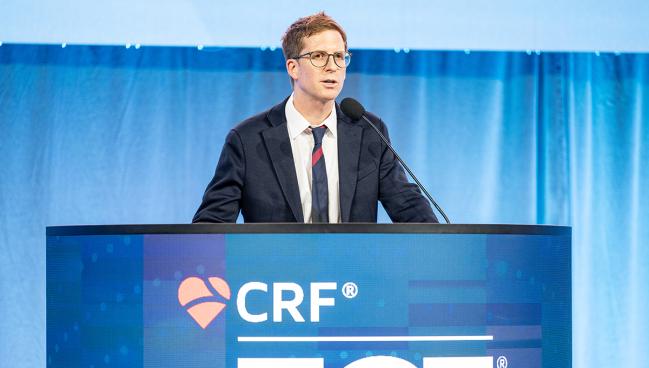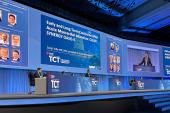Co-STAR Hints That Colchicine May Curb Rhythm Disturbances After TAVI
The trial was small and halted early, but investigators say the inflammatory hypothesis in TAVI is worth pursuing further.

WASHINGTON, DC—The short-term use of colchicine at the time of TAVI for severe aortic stenosis may curb the risk of new-onset atrial fibrillation (AF) and the need for a new permanent pacemaker, the small, single-center Co-STAR study hints.
Colchicine also appeared to reduce the risk of leaflet thickening at 30 days in a subgroup of patients who underwent 4D-cardiac computed tomography angiography, investigators reported at TCT 2024 last week.
Unfortunately, the trial was stopped early after five strokes occurred in the colchicine-treated patients (with three occurring in the first 2 weeks) compared with none in the placebo arm. Investigators, however, don’t believe the strokes were attributable to the anti-inflammatory medication.
“There was, at baseline, a higher prevalence of a history of stroke compared to patients in the placebo group,” said lead investigator Thomas Pilgrim, MD (Bern University Hospital, Switzerland). “We know that a history of stroke puts you at a higher risk for stroke.”
Furthermore, data on the use of colchicine for coronary artery disease have not raised safety concerns. “There are quite a few trials with colchicine,” he continued. “There was never this signal of stroke, so I assume that this may rather have been a chance finding.”
Of note, however, a separate, much larger study presented at TCT, CLEAR SYNERGY, showed no benefit to colchicine in reducing the risk of major adverse cardiovascular events in patients treated with PCI after acute myocardial infarction.
Too Good to Be True?
Inflammation is known to increase the risk of cardiac arrhythmias, said Pilgrim, and colchicine has been shown to be effective in reducing AF in patients after cardiac surgery.
“With regards to rhythm disturbances and [atrioventricular block] after TAVI, we are always focusing on device type—self-expanding and balloon-expanding valves—and on the depth [of implantation],” said Pilgrim, explaining the trial’s rationale. “But maybe it’s also about inflammation because you have inflammation in the landing zone [resulting from] the pressure with which you implant the valve.”
In all, 60 patients were started on colchicine 1 mg a day prior to the procedure and continued on a 0.5-mg dose for 12 days; sixty were randomized to placebo. All patients (mean age 80) underwent continuous rhythm monitoring and ECG recording to assess the primary endpoint of new-onset AF or conduction disturbances requiring a new pacemaker.
Of those treated with colchicine, 8.3% had a prior history of stroke compared with none in the placebo group. The majority of patients—62.7% and 70.7% in the colchicine and placebo arms—were treated with a balloon-expandable transcatheter heart valve.
The primary endpoint of new-onset AF or new permanent pacemaker implantation at 30 days occurred in 10% of those treated with colchicine compared with 25% of those treated with placebo (P = 0.031). The rates of new-onset AF were 5.0% and 6.7% in the colchicine- and placebo-treated patients, respectively, while the rates of new permanent pacemaker implantation were 8.3% and 18.3%, respectively (both not statistically significant differences).
In a subset of 48 patients who underwent imaging, the risk of a more than 50% reduction in leaflet motion or leaflet thickening was 27.1% in those treated with colchicine versus 54.2% in the placebo group (P = 0.007). This difference was driven by a reduction in reduced leaflet thickening in the colchicine-treated patients. There was no difference in antithrombotic treatments after TAVR between the two groups, with most patients treated with single antiplatelet therapy, said Pilgrim.
Investigators would like to test the inflammatory hypothesis again, but given Co-STAR’s stoppage by the data and safety monitoring board, it would make sense to try a different anti-inflammatory agent, said Pilgrim. Other drugs, however, would be pricier.
That's what was so attractive about colchicine, Pilgrim told TCTMD. “It would be so good to take a cheap therapy for 2 weeks only. It's not like you need to take an expensive drug for 2 years to see a small effect. But who knows, maybe it’s too good to be true.”
Wayne Batchelor, MD (Inova Heart and Vascular Institute, Fairfax, VA), said he was intrigued by the findings but stressed that the study is severely hampered by its premature termination.
“It would have been nice to have a larger trial,” he told the media during a press conference. “This is hypothesis generating. It is not definitive by any stretch of the imagination, especially when you see that it took the combined trend of slightly fewer atrial fibrillation events and slightly few pacemakers to meet the statistical significance.”
Michael O’Riordan is the Managing Editor for TCTMD. He completed his undergraduate degrees at Queen’s University in Kingston, ON, and…
Read Full BioSources
Ryffel C. Colchicine in patients with aortic stenosis undergoing transcatheter aortic valve replacement: a double-blind, randomized, controlled trial. Presented at: TCT 2024. October 29, 2024. Washington, DC.
Disclosures
- Pilgrim reports grant/research support from Edwards Lifesciences, Boston Scientific, Biotronik; consulting fees/honoraria from Edwards Lifesciences, Medtronic, Biosensors, HighLife SAS; and other from ATSens.





Comments